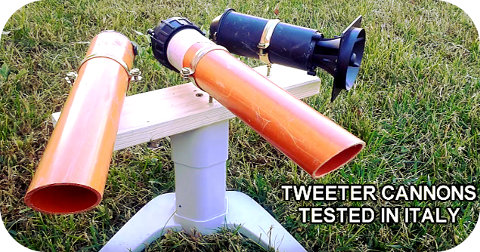Difference between revisions of "Ultrasonic Dog Barking Deterrent"
m |
|||
| Line 22: | Line 22: | ||
As documented by an individual on youtube.com a man in Italy has constructed some experimental Dog Control Sound Cannons. The youtube video provider narrates an analysis of the devices including potential problems with their design. This provides a good starting point for the construction of a better mouse trap. | As documented by an individual on youtube.com a man in Italy has constructed some experimental Dog Control Sound Cannons. The youtube video provider narrates an analysis of the devices including potential problems with their design. This provides a good starting point for the construction of a better mouse trap. | ||
| − | [[File:nobarksoundcannon.jpg]] | + | [[File:nobarksoundcannon-sm.jpg]] |
According to the video, the Italian developer of the cannon noted the ineffectiveness at ultrasonic frequencies, however, determined it to be highly effective at high sonic frequencies. Apparently, the dogs whimpered, and tried hiding behind objects. The video narrator suggests that with modification by selecting equipment that would be efficient in the ultrasonic range the same results could be achieved using sound a human could not hear, which is the goal. | According to the video, the Italian developer of the cannon noted the ineffectiveness at ultrasonic frequencies, however, determined it to be highly effective at high sonic frequencies. Apparently, the dogs whimpered, and tried hiding behind objects. The video narrator suggests that with modification by selecting equipment that would be efficient in the ultrasonic range the same results could be achieved using sound a human could not hear, which is the goal. | ||
Revision as of 08:47, 25 June 2019
The use of high frequency audio at a relatively intense level to influence a dog to cease barking.
Dogs are capable of hearing higher frequencies than humans. At sufficient volumes, frequencies above 25,000 Hz become irritating for dogs. The louder and higher those sounds are, the more uncomfortable for the dog they become. Dogs may whimper, whine and run away if confronted with a sufficiently loud and high-frequency sound.
Dog whistles can be in the range of 23,000 Hz or higher, however, lack the level of intensity to deter a dog from barking. Such a device is only useful for signaling a dog to perform simple acts with training. Sounds of a frequency between 23,000-25,000 Hz are inaudible to humans, but are tolerable for dogs.
Purchasing Commercially Available Device
The problem with commercially available ultrasonic dog barking deterrents is they lack sufficient intensity and range to be effective against a neighbors barking dog. Although the dog next door might be able to hear the device, it would be the equivalent to a human hearing a wind-chime. The dog might respond at first, but merely out of curiosity then simply ignore the sound in some cases even become accustomed to it and enjoy it.
- Commercially available ultrasonic dog barking deterrent = pleasant wind-chime to the dog next door.
Again, these devices might have an effectiveness on your dog at close proximity when properly used, however, are completely ineffective at any appreciable distance beyond a few feet.
Construction of an Ultrasonic Dog Barking Deterrent
As a project this device will be constructed and tested with the results documented here. Based on existing research the following lays out plans for the device.
- acquisition of the correct high frequency piezoelectric tweeter - This is important as many piezo tweeters are incapable of efficiently producing intense ultrasonic sound.
- construction of an efficient audio driver for the piezoelectric tweeter - this includes the audio oscillator stage and the audio amplification stage.
- audio directing barrel - Simple PVC pipe of the correct diameter and length to help direct the already highly directional ultrasonic audio. You want to focus on the culprit canine and reduce splatter that might negatively impact other animals
As documented by an individual on youtube.com a man in Italy has constructed some experimental Dog Control Sound Cannons. The youtube video provider narrates an analysis of the devices including potential problems with their design. This provides a good starting point for the construction of a better mouse trap.
According to the video, the Italian developer of the cannon noted the ineffectiveness at ultrasonic frequencies, however, determined it to be highly effective at high sonic frequencies. Apparently, the dogs whimpered, and tried hiding behind objects. The video narrator suggests that with modification by selecting equipment that would be efficient in the ultrasonic range the same results could be achieved using sound a human could not hear, which is the goal.
Online Resources
Here is an individual that has spent time doing testing as well as coordinating with others over tackling this problem
A discussion on "Instructables" by myxpykalix
